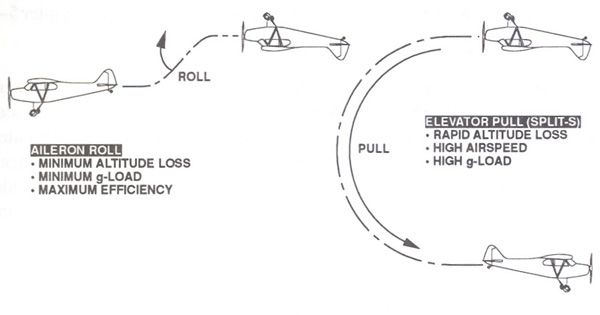During the Upset Recovery Training Course at APS, we put our clients into a wide variety of scenarios that prepare them for the over-bank or “upset” flight condition. In any overbank scenario, the ultimate goal is to keep the aircraft flying (ie. unstalled), re-orient the lift vector to an upright attitude and then initiate recovery to a climb away from the ground. If you haven’t been through upset recovery training or had aerobatic instruction previously, this is much easier said than done.
The Split S – Page 120
Emergency Maneuver Training: Controlling Your Airplane During a Crisis
IMPORTANT NOTE: It must be emphasized that the Split-S Maneuver shown in this video (below) is an exercise in what NOT TO DO in an overbank situation. We find it to be a very effective and dramatic technique to demonstrate the risks, life-threatening dangers and challenges of the split-s pull through response to an over-bank situation in-flight. As a few of our members have already observed, in an over-bank situation the pilot needs to continue the roll around to upright flight using an unloaded aileron roll type maneuver.
At APS, the demonstration of this Split-S Maneuver takes place in the second flight of the 3-mission, 5-mission or 6-mission course immediately following an in-depth flight training session on cross-controlled stalls. In the cross-controlled stall exercises, the aircraft often ends up in an over-banked flight condition (especially the skidded turn traffic pattern stall). Now, it’s important to recognize that it doesn’t matter how we got over-banked, the fact is that we are there and need to respond correctly with an unusual attitude recovery. Scenarios leading to an over-bank flight condition include; wake turbulence upsets, a spiral dive, pilot distraction, cross-controlled stalls and/or wind shear, just to name a few.
Statistically (at APS), a whopping 80% of pilots exposed to their first over-bank scenario initially react with the panic response of “PULL TO MAKE THE HOUSES SMALLER”. This is understandable considering the vast majority of pilots spend 99.99% of their flight time at less than 45 degrees of bank where PULL does mean THE HOUSES GET SMALLER. Unfortunately, in an over-bank scenario (usually in excess of 75 degrees of bank at APS), a pull or aft movement of the control column only buries the flight attitude of the aircraft steeper into a dive. To drive home the adverse consequences of pulling in an overbank scenario, the clients at APS get to fly through a full Split-S maneuver with both power-on and power-off to witness first-hand how all the maximums and/or limitations of the pilot and aircraft are immediately forced upon them because of burying the nose from a pull. What maximums are we referring to in the Split-S? They are:
- Rapid Altitude Loss (usually 1000s of feet)
- Rapid Acceleration Above Maneuvering Speed and Possibly Beyond Vne
- High G-load.
- Typically right up to the limit load of the aircraft. 3.8 Gs in the Normal Category
- G-loading approaching 3.8 G or more (if a panic pull above maneuver speed is made) can bring the pilot to or beyond their physiological limit imposing the risk of G-Induced Loss of Consciousness (G-LOC).
- Not to Mention the Inherent Disorientation of the Maneuver Itself
- Note in this video that we do not exceed the Normal Category G-limit of 3.8 G. Of course, the Extra 300L has a 10 G envelope which adds a huge margin of safety to the APS training, but we recognize that clients come to us to be exposed to the flight envelope of their aircraft … and that is exactly what we do to the best of our ability during the entire training program.
 So what’s the moral of this story? Simple. In an over-bank scenario DON’T PULL … immediately apply Unusual Attitude Recovery Techniques to re-orient the lift vector, minimize altitude loss and get away from the ground. Please take a moment to look at the image to the right. Would you roll upright from this in-flight upset condition the first time you were there? We can only hope … if not, have a look at the video below to see what happens when we pull through. Better yet, come get some life-saving (and fun) training from APS or any other recognized aerobatic training flight school… Safe journeys to all!
So what’s the moral of this story? Simple. In an over-bank scenario DON’T PULL … immediately apply Unusual Attitude Recovery Techniques to re-orient the lift vector, minimize altitude loss and get away from the ground. Please take a moment to look at the image to the right. Would you roll upright from this in-flight upset condition the first time you were there? We can only hope … if not, have a look at the video below to see what happens when we pull through. Better yet, come get some life-saving (and fun) training from APS or any other recognized aerobatic training flight school… Safe journeys to all!





I watched years ago a T2D entering that maneuver awfully low, maybe at about 1200 to 2000 feet over a
narrow river crossing the city.
Right at this precise moment I knew he was not going to make it.
Effectively, it crashed at about half a mile away from my place.
Both guys were instantly killed.
Lousy scene that I have intended to erase over time unsuccessfully.
Omar, we are very sorry to hear about the unecessary loss of life, and regretably, we understand all too well the scars that these events can cause. It is our sincere hope that the important work that we all undertake at APS can help to reduce accidents such as this, and other tragedies. Our purpose is to Help Pilots Bring Everyone Home Safely, and we are all motivated and work hard each day to do just that.